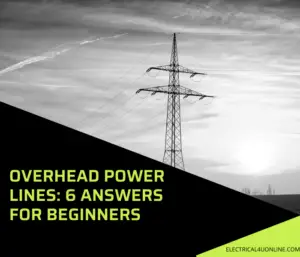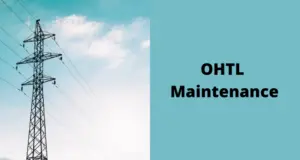The electrical power system consists of different sections. The main sections are Power generation, transmissions, and distribution.
Overhead transmission lines are the main sources for transmission and distribution of high voltages for long distances.
In this article, I will discuss types overhead transmission lines faults, their causes, and how to protect them.
Table of Contents
The most common fault on overhead transmission lines
One of the most common faults on an overhead transmission line is a short circuit. Short circuits can occur when conductors come into contact with each other, or when a conductor comes into contact with a grounded object.
This can result in a sudden surge of current, leading to equipment damage, power outages, and potential safety hazards.
Other common faults on overhead transmission lines include:
- Open Circuit: This occurs when there is a break in the continuity of the conductor, leading to a loss of current flow.
- Line-to-Ground Fault: This happens when one of the conductors comes into contact with the ground, leading to an unbalanced current flow.
- Phase-to-Phase Fault: This occurs when two conductors of different phases come into contact, causing a short circuit between them.
- Corona Discharge: Corona discharge happens when the electric field around a conductor ionizes the surrounding air, creating a faint glow and loss of energy. While not a direct fault, corona discharge can lead to increased power losses and radio interference.
- Weather-Related Faults: Adverse weather conditions, such as high winds, heavy snow, or ice accumulation, can lead to conductor damage, insulator flashovers, and other faults.
Utilities employ various protective devices and monitoring systems to detect and mitigate these faults promptly, ensuring the reliability and safety of the transmission line.
Regular maintenance and inspections are also crucial to identify and address potential issues before they lead to faults.
Faults I See in My Workplace
We use 11KV OHTL network to transfer power from generation station to loads. Our network is aged and has many faults. Below are some faults.
- Blown fuse.
- Cut wire.
- Broken insulator.
- Short circuit.
- Flash over.
- Lightning strike.
- Hot spot due to loosen connection.
- Burnt OHTL wooden pole.
Now let’s discuss this topic in more details.
Types of faults in Overhead transmission lines
A fault is defined as any unusual condition in the transmission line due to any reason. This may include smoke, fire, sparking, broken insulation or any other effect.
Two basic types of Faults in Transmission lines are:
- Series faults.
- And shunt faults.
The series faults are also considered as open conductor faults. While shunt faults are also referred to as short circuits faults. Let’s discuss both types in detail.
Series Faults:
This type of faults is also referred to as open Circuit fault. And can be defined as faults caused due to the failure of a single or multiple conductor.
Causes of Open Circuit (Series) Faults:
- The major causes of open-circuit faults are joint failures of overhead lines.
- Similarly, failure of a circuit breaker or function of the circuit breaker in multiple phases.
- Melting of fuse conductor.
- Cut in the conductor. This fault I meet regularly in my work, because of the aged conductors.
Effects of Series faults:
Series faults are dangerous for live things like animals as well as humans.
Due to a series of faults, the system operations disturb and the system goes to an abnormal or unstable state.
Due to abnormal conditions, voltage fluctuations occur, High voltages can cause short circuit faults.
Troubleshooting To protect the system from damages it is mandatory to make regular inspection to detect any abnormal condition and to overcome the situation as soon as possible.
In the company I work for, We hire a third party company to make live check and re tighten all joints. And check all conductors for any possible damages.
Shunt Faults (short circuit Faults)
Shunt faults are caused due to low impedance between two points with different voltage levels. This allows the flow of a high amount of current into Overhead transmission lines.
Causes of shunt faults:
The main causes of shunt faults are insulation failure between different phases of conductors, but as you know OHTL conductors are not insulated, so this fault can happen if a bird break down the air insulation between two conductors. Other causes may include aging of transmission line, damage by any reason and lightning, etc.
Effects of shunt faults:
Just like series faults, shunt faults also have a negative impact on transmission lines. Shunt fault can cause fire or explosion to equipment attached with transmission lines such as circuit breakers, transformers, etc.
- The voltage fluctuation can cause damage to the devices or equipment attached to the transmission line.
- The supply of electric current disconnects if shunt faults persist for long times.
- Just like voltage fluctuation, shunt faults also cause current fluctuations. If the current level increase from the rated current of the device attached to the power system or transmission line.
It overheats and either completely damage the device or reduces the working life span of the equipment.
Further classification of Series and shunt faults
Series faults are further classified into one open conductor fault & two open conductors faults. However, the occurrence of these faults is very less. The best way to identify these types of faults is to observe each phase current. If the value of phase current increases it means that there exists a short circuit fault.
Similarly, shunt faults are further classified into symmetrical faults and asymmetrical faults. Further distribution of symmetrical faults is:
- Triple line (LLL)
- Triple line to ground (LLLG) faults.
Further distribution of Asymmetrical faults is:
- line to ground (LG)
- line to line (LL)
- Double line to ground (LLG)
Natural causes of faults in overhead transmission lines
We listed some basic types of faults that may occur in an overhead transmission line. However, these are normally man-made. Besides the above, here we are discussing some natural causes of faults in overhead transmission lines.
Lightning
Lightning is one of the main sources for causing a faults in overhead transmission lines. To reduce the effects of lightening different approaches are common.
The best approach is to install an arrester to prevent the flashover of insulator assemblies. Besides this, employing multiple shielding wires, lowering the footing resistance, and differential insulation techniques are also in use.
Fire
Fire is another natural source for causing electrical faults. Due to the burning process, the particles accumulate on the transmission line surfaces. Which causes resistance to the flow of current.
Pollution
Due to pollution dust particle accumulates on the surface of transmission lines insulators. this includes salt particles and dust. Which also reduces the insulation strength of the insulator string. Which causes a flashover.
We hire a third party company to clean the insulators of the entire network using water, while the line is live. This is the best way to do the cleaning job, It is cost effective.
The live cleaning crew is well trained and authorized to do such job.
Loosen connections
I use thermal imaging in my work to detect any hot spots at the OHTL. The main source of hot spots is loosen connection or bad contacts.
Aging, human mistake during installation or high pollution can cause this fault. If we fail to detect it, The heat increases and then causes wire, bolts and joint to melt.
Aging and wire corrosion
Aged OHTL network is highly affected by environmental conditions. I face this all the time in my work. The aged network wires get corroded and cut. A good protected OHTL will cause the main medium voltage to interrupt in case of any wire cut.
The best solution of this fault is to replace the old wires. It will cost much, But it worth the cost.
Other natural sources
Some other common sources that cause faults to overhead transmission lines are trees, ice, fog, abnormal loading, heavy rains, and high speed wind, etc.
Effects of Faults
Faults affect the whole power system. Therefore it is mandatory to handle it as soon as possible. Some common effects of faults are:
- Damaging of insulators.
- Tripping of protection relays.
- Damages caused to a device attached due to overcurrent or overvoltage.
- Electric shocks.
- Initiate fires or sparking
- Reduce the life span of attached equipment.
Protection of Overhead transmission lines
The protection of overhead transmission lines varies with the type of line. i.e. if the overhead transmission line is LV. You can use different control methods like relays and fuses to overcome the situations.
However, if it is an HV transmission line then relays, fuses or current-limiting devices might not work.
We can protect HV transmission lines by two different methods i.e
Again, it depends upon the length of the transmission line. IF the HV line is of a short distance then we can protect it via Differential and phase comparison protection techniques.
If the HV transmission line is more than 80 Km. Then we use distance protection techniques to protect the transmission lines from different types of faults.
Don’t Leave Empty-Handed!
Install my Free Android App on Google Play:
Electrical Cables Most Common Tables “Cables Tables”
And, my Electrical Calculations App “Fast Electrical Calculator”
Discover more great content by subscribing to My channel
Looking to stay ahead of the game in the world of electrical engineering? Subscribe to my YouTube channel and gain access to exclusive content you won’t find anywhere else!
The staff I recommend
(Amazon Affiliate Links to products I believe are high quality):
- Economy 120 Volt/60Hz AC Power Source – Step-Down Voltage & Frequency Converters 1800W
- UNI-T Digital Multimeter Tester UT139C
- 50-Amp Extension Cord for RV “100ft”
- Voltage Stabilizer 110/220v
- Hair Dryer “best selling“
- TOSHIBA EM131A5C-BS Countertop Microwave Ovens
Disclaimer: This contains affiliate links to Amazon products. I may earn a commission for purchases made through these links.


